@AMSTERDAM _MACAM, May 8-10 2019
written/compiled by Harold Schellinx
may 2019
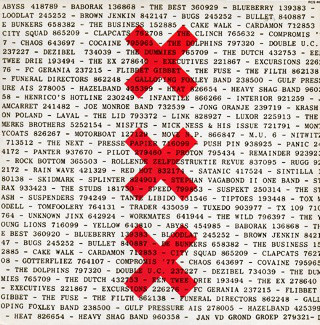 ...
...
The coat of arms of the city of AMSTERDAM has three crosses. This is why you will come across these crosses —symbol for the city— everywhere in (official and unofficial) Amsterdam-related publications and in Amsterdam public space, probably most notably on the many, many red-brown steel traffic bollards called Amsterdammertjes, that are used to separate sidewalk from street all over the city. The crosses are Saint Andrews crosses and the symbol is generally believed to go back to knight Jan Persijn and his family of nobles, who owned a lot of land in and around Amsterdam. Knight Persijn was 'Lord of Amsterdam' from 1280 to 1282.
...
Though it is not the seat of the Dutch government, by special constitutional mandate, AMSTERDAM is the capital of the Kingdom of the Netherlands. (The government is in Den Haag, a city south-west of Amsterdam and more pompously also called: ’s-Gravenhage, in English: The Hague.)
The name AMSTERDAM memorises the city’s origin: a small fishing village in the late 12th century around a dam in the river Amstel.
Current population size of the Amsterdam urban area is around 2.5 million, that of the city of Amsterdam itself about 850,000. Large parts of the relatively small city centre are, especially in spring, summer time and the other holiday seasons, infested by herds of visitors and tourists that flood many of the narrow streets and small squares, leading to continuing fierce complaints and protests from the people that live and work (other than in the tourist industry) in these parts of town, and a municipality torn between the need to consider the city's financial balance, profiting from all the money spent by visitors and tourists, and the wish to regulate and/or ward off a substantial part of the current visitors' volume in order to keep the city centre liveable for its citizens.
“Art is a diverse range of human activities in creating visual, auditory or performing artefacts, expressing human —often more specifically: the artist(s)/author(s)'s— imaginative, conceptual ideas or technical skills, in many cases, though not always (and sometimes explicitly not), intended to be appreciated for their beauty or emotional power.”
[ cf. Oxford Dictionaries, slightly adapted ]
Visits & meetings - schedule
- Wednesday May 8th
- 12h30-13h00 — Concertgebouw Orchestra / lunch concert
- 14h00-15h30 — STEIM / meeting
- 15h30-16h00 — De Appel / expo
- 17h00-18h00 — Mondriaan Fund / meeting
- 21h00-23h00 — Frascati / theatre, dance performance
- Thursday May 9th
- 10h00-11h45 — Stedelijk Museum / expo
- 12h00-13h00 — Paradiso / meeting, tour
- 14h00-15h30 — De Brakke Grond / meeting, tour, expo
- 15h30-15h45 — Gonzo (Circus) Magazine / meeting
- 16h00-17h00 — W139 / meeting, expo
- 17h00-18h00 — city punk/squat/1980s walk with DJ Oscar Smit
- 21h00-23h00 — ITA / theatre performance
- Friday May 10th
- 09h30-10h30 — Amsterdam Dance Event, VondelCS / meeting
- 11h00-13h00 — Gerrit Rietveld Academie / meeting, expo, tour
- 14h00-16h30 — Rijksmuseum / expo
National and Local Art Funding in the Netherlands
The Performing Arts Fund NL (Fonds voor de Podiumkunsten) is the main Dutch national culture fund for music, theatre and dance, providing financial support to every form of the professional performing arts on behalf of the government.
With a few exceptions, only artists or organisation that are residing in the Netherlands are eligible for grants awarded by the Fund.
The Performing Arts Fund is based in The Hague.
The ☆ Mondriaan Fund (Mondriaan Fonds) is the public fund for visual art and cultural heritage in the Netherlands. The fund's name is that of the famous Dutch and expatriate 'neoplasticist' painter and art theoretician Piet Mondriaan (1872-1944), one of the founders of the Dutch movement De Stijl and a pioneer of 20th century abstract art, who lived mostly in Paris, London and New York. 'Mondriaan' is Piet's original Dutch family name. He 'un-dutch-ified' it, and began calling himself 'Mondrian' when he moved to Paris.
The Mondriaan Fund's offices are at the Brouwersgracht 276 in Amsterdam. We met there with senior international project officer Mayke Jongsma. [up]
The Amsterdams Fonds voor Kunst (AFK, Amsterdam Art Fund) is the cultural fund supplier of the city of Amsterdam, available for cultural organisations and artists of all disciplines and from every district of the city. The AFK is located in one of Amsterdam's urban cultural resorts ('breeding spaces') Pakhuis De Zwijger, Piet Heinkade 179, north of Central Station.
☆ Royal Concertgebouw Orchestra (since 1888, ‘royal’ since 1988)
Considered one of the world’s leading symphony orchestras. The Concertgebouw orchestra had a close working relationship with composer Gustav Mahler (1860-1911).
More recently, in August 2018, the orchestra dismissed its eighth chief conductor, Danielle Gatti, after allegations of sexual misconduct (denied by the conductor).
A successor for Gatti has not yet been appointed.
[ www.concertgebouworkest.nl/en/royal-concertgebouworchestra-amsterdam ]
We attended a public rehearsal of the Concertgebouw orchestra, performing Witold Lutoslawski's Concerto For Orchestra (1950-54), conducted by Peter Eötvös. [up]
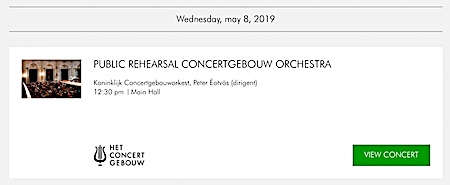
Museumplein
The Concertgebouw concert hall is facing the Museumplein (Museum square), which, as its name indicates, is the place where one will find the three major Amsterdam public museums for visual arts, as well as —since 2016— a private (boutique-)museum.
- the ☆ Stedelijk Museum for modern and contemporary art/design. 'Stedelijk' means 'municipal'. The Stedelijk (the abbreviated name by which it is commonly known) was privatised in 2006, the goal being to endow the institution with a more business-like approach. Now an independent association, the Stedelijk leases the building from the city of Amsterdam and manages, maintains and extends the municipal art collection on behalf of the city council.
 It is, arguably, the most important museum for contemporary art in the Netherlands. Closed at the insistence of the local fire department, starting in 2003 the museum's building underwent major reconstructions, which forced the city's modern art collection to move, first, to a temporary location (in the no longer existing Post CS Building, demolished in 2009) near the Central Station, only to be re-moved again, also from there, making the Stedelijk for quite a number of years into an Amsterdam art entity sans domicile fixe. The museum re-opened to the public on the Museumplein in 2012.
It is, arguably, the most important museum for contemporary art in the Netherlands. Closed at the insistence of the local fire department, starting in 2003 the museum's building underwent major reconstructions, which forced the city's modern art collection to move, first, to a temporary location (in the no longer existing Post CS Building, demolished in 2009) near the Central Station, only to be re-moved again, also from there, making the Stedelijk for quite a number of years into an Amsterdam art entity sans domicile fixe. The museum re-opened to the public on the Museumplein in 2012.
We visited the Stedelijk on Thursday morning. [[tweet]] [up] - the Van Gogh Museum, with the world's largest collection of works by Dutch expatriate and troubled painter-genius Vincent van Gogh, during his life time misunderstood and largely ignored.
- the ☆ Rijksmuseum is the national —'rijk' means 'state'— museum whose public mission it is to offer a representative overview of Dutch art and history from the Middle Ages onwards, as well as of major aspects of other European and Asian art. Like the Stedelijk Museum, also the Rijksmuseum's building recently was subject to drastic rebuilding and restauration. The works, that started in 2003, were originally said to take only a few years, but eventually the museum's main building was re-opened to the public again not before the spring of 2013. Currently, on the occasion of the old Dutch master and painting star Rembrandt's 350th year of death, the museum presents, for the first time in its history, its full collection of Rembrandt van Rijn's works. [up]
- the MoCo Museum is a private museum focusing on (fashionable) modern and contemporary art, located in Villa Alsberg, a static town house. It was founded by gallery owners Lionel and Kim Logchies, and opened in April 2016.
From Autonomous Art Spaces (free havens) to Broedplaatsen (breeding spaces)
Amsterdam and the Netherlands have a long tradition of autonomous artist run spaces, which in most cases were set up on abandoned sites and in evacuated or abandoned buildings (sometime whole streets or even complete city blocks and city quarters), which then were squatted and restored, re-made, re-modelled by (mostly but not exclusively) students, artists and (left-wing or anarchist) activists. One among many examples is the village of Ruigoord, within the municipality of Amsterdam (to the West of the city), which was evacuated in the 1960s when Amsterdam intended to use it as an extension of its harbours. When these plans failed to be realised, the village was squatted and taken over by artists in 1973. Nowadays with a legalised status, the village of Ruigoord always remained an exclusively art centred community.
Until only recently one of the last surviving large scale autonomous artistic free haven communities within the city of Amsterdam was the ADM (acronym of ‘Amsterdamse Droogdok Maatschappij’), the site of a disused, derelict shipyard in the Port of Amsterdam. Originally squatted in 1997, ADM evolved into a vibrant artistic community that for more than twenty years harboured local and international cultural events, concerts, workshops, exhibitions, festivals (like Robodock, an international festival around robotics, spectacle theatre, fire shows, multimedia, design and industrial installations).
The ADM however was evicted on January 7th 2019, including its 125 inhabitants. The artists’ houses, studio's and other work- and performance spaces were demolished. The terrain now allegedly is being prepared by its current owner for industrial purposes.
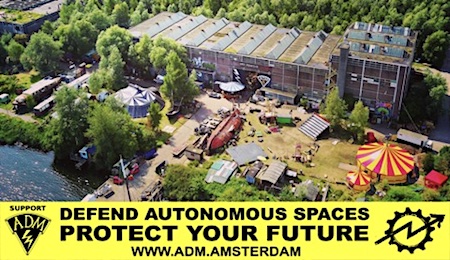
Parallel to the introduction of legislation that has made squatting —the occupation of unused and abandoned or evacuated real estate for work and residential use— from being legal and allowed or, at least (under well-defined but relatively broad conditions) tolerated, into an unlawful and hence criminal activity, national and local policy makers little by little have institutionalised (hence deviously neutralised as a political but also as an artistic force) the practice and philosophy of these (formerly independent, autonomous) artist run urban spaces in the guise of so-called culturele broedplaatsen (cultural breeding spaces or creative urban incubators): disused and neglected buildings where cultural institutions, independent artists, entrepreneurs and start-ups can rent workspace at a —relatively— low pricing.
The municipality of Amsterdam currently manages and supervises about 60 of such 'breeding spaces'.
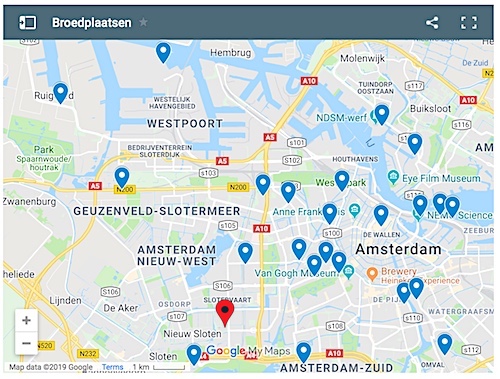
On Wednesday May 8th we will visit STEIM and De Appel, two internationally renowned Amsterdam art institutions that, as part of the changing cultural politics & economy, were re-located by the municipality and moved from their accommodations in the centre to a suburban 'breeding space', the ☆ Urban resort Lely, in a former school building, the Calvijn College, Schipluidenlaan 12 in the Slotervaart neighbourhood, south of the city's centre. (Its location is indicated by the red pin in the map above).
☆ STEIM (STudio for Electro-Instrumental Music)
STEIM is an independent electronic music center founded in 1969 by a group of young Dutch composers (Misha Mengelberg, Louis Andriessen, Peter Schat, Dick Raaymakers, Jan van Vlijmen, Reinbert de Leeuw, Konrad Boehmer) that at the time fought for the reformation of Amsterdam's feudal music structures, most notably by causing a public scandal when they disrupted a performance of the Concertgebouw Orchestra  by making an lot of noise. From 1981 until his untimely death in 2008, the STEIM center was led by performer, improviser, inventor and live-electronic-music pioneer Michel Waisvisz. STEIM initially focused on developing tools for experimental electronic musicians for live stage performance art, and still carries the 'touch philosophy' as its motto: "Touch is crucial in communicating with the new electronic performance art technologies".
by making an lot of noise. From 1981 until his untimely death in 2008, the STEIM center was led by performer, improviser, inventor and live-electronic-music pioneer Michel Waisvisz. STEIM initially focused on developing tools for experimental electronic musicians for live stage performance art, and still carries the 'touch philosophy' as its motto: "Touch is crucial in communicating with the new electronic performance art technologies".
We met with STEIM's current artistic director, Dick Rijken. [[tweet]] [up]
☆ De Appel
De Appel, founded in 1975, is among the eldest not-for-profit contemporary arts institutes in the Netherlands. It developed into a well-known centre for performance, installations and video art a time that these art forms were still in their infancy. In its currenf form, based at urban resort "Lely", De Appel organizes exhibitions, performances, film screenings, lectures and gatherings that search and continue to cross boundaries between the arts and other disciplines.
After our meeting at STEIM, we visited Landscape with Bear, an exhibition composed from the 'objects within a small section of De Appel’s archive – artworks, props, leftovers, and unidentified materials – that have come to be known as the “Collection (Unintended)”', by participants in De Appel's curatorial programme. [[tweet]] [up]
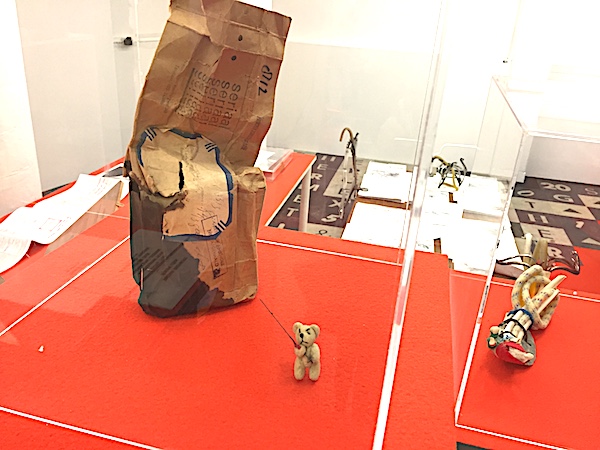
☆ W139 - Warmoesstraat 139
Originally one of the many evacuated and abandoned buildings in the city centre that were squatted and occupied by artists and activists in the late 1970s and early 1980s, W139, short for the centre's address Warmoesstraat 139, this year celebrates its fortieth year as an autonomous art centre (the W139 collective eventually bought the building, and now owns it), "providing artists time and space for free explorations in the heart of Amsterdam".
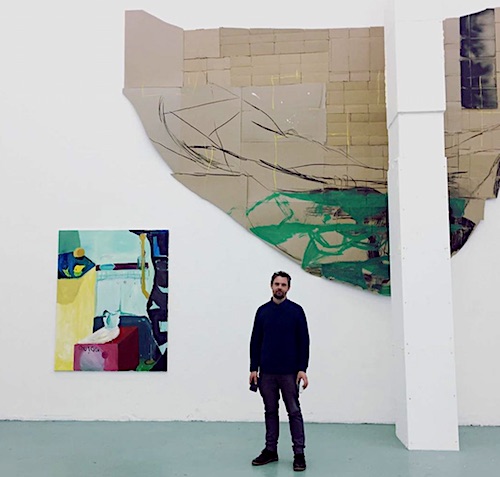
We visited W139 and met and had tea & cakes with members of the current W139-staff, and with the artists currently exposing in the centre. [up]
OT301 - Overtoom 301
OT301 is located on the Overtoom in what used to be home to the Netherlands Film Academy. After the academy moved (in 1999) to its current location on the Markenplein, a little nort-east opposite the Wartelooplein, the former academy's premises were squatted by a group of artists, that later on (in 2006) managed to buy the building from the city council. OT301 has been an autonomous social-cultural center and artist space ever since, ran by a collective of 24 members that together from a 'creative non-profit organisation' offering a public programming and a stage for ‘experimental’, ‘new’, ‘alternative’ art, music, film, dance, theatre, workshops and "other sorts of performances and shows we choose to put on".
Nes
The Nes, is a narrow, old street in the centre of Amsterdam, parallel to the avenue-sized Rokin and not far from Dam Square. Nes is one of the 'theatre districts' in the centre of Amsterdam.
- ☆ Frascati, has four theatre spaces on the Nes, in which the theatre presents yearly some 700 different Dutch and international productions. Frascati also yearly produces some thirty large and smaller-scale productions itself.
On Wednesday evening we attended the interactive performance Trans:plant, "exploring ‘plant thinking’ as an alternative way of thought and life, [...]". In the wake of the work we met and discussed with Swiss choreographer and dancer Emilia Giudicelli, and French musician Grégoire Paultre. [[tweet]] [up]
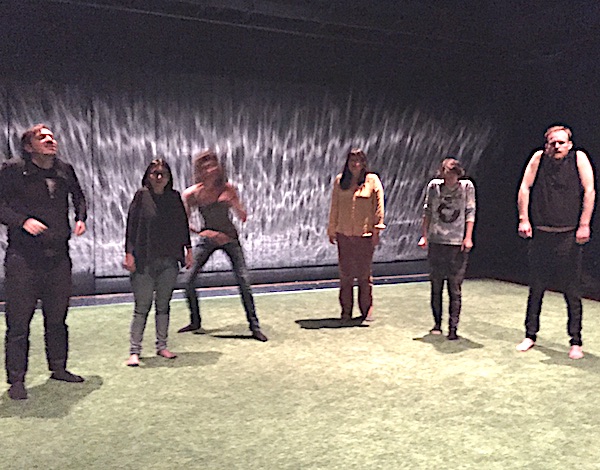
- TOBACCO Theater. A former tobacco factory that is rented out for self-sustaining cultural events and productions.
-
☆ De Brakke Grond, is a Flemish Arts Centre whose mission it is to bring to Amsterdam and the Netherlands a wide selection of innovative contemporary art productions from Flanders (the Dutch speaking part of Belgium): dance and theatre, music, performance, visual art, literature, film, design, fashion, architecture, new media... On Thursday May 9th we met with managing director Bart Govaert and head of communications, Bettina Lorsheijd.
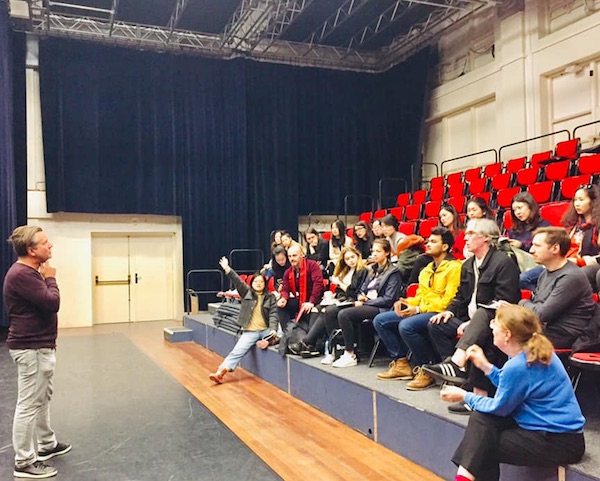
We also visited the centre's current exhibition of the work of photographer and video maker Camille Piquot (A thin line between truth and fiction). [up]
In the Brakke Grond's building there is also the small editorial office of Gonzo (Circus) Magazine, a bi-monthly Flemish/Dutch culture and music magazine, first published in 1991 in Belgium. GONZO focuses on contemporary musical genres like improvised music, modern classical music, rock, noise, modern jazz, electronic music and world music. After our tour of De Brakke Grond, we met with Gonzo's managing director Ruth Timmermans. [[tweet]] [up]
Leidseplein area
The Leidseplein area is one of the (some will say: the) major night life center of Amsterdam. On and around this square ('plein' is the Dutch word for 'square', Leiden is a town to the south of Amsterdam, not far from The Hague) you find a number of renowned concert and theatre halls.
- The history of ☆ Paradiso, a pop/rock music venue housed in a former church building of the Dutch Vrije Gemeente on the head of the Weteringschans, a broad street leading up to the Sarphatistraat and the river Amstel, goes back to 1967 when the abandoned church building was squatted by hippies, asking the city of Amsterdam for an entertainment and leisure club for Amsterdam's then quickly growing and strongly self-asserting pop-and youth culture community. Their request was granted, and consequently, the year after, in 1968, Paradiso opened as a publicly subsidised youth entertainment center. In the decades that followed, for a great many UK and American (progressive) rock bands in their early career, performing at the Paradiso became something like a holy grail, paving, as it did, the way to conquering a big & lucrative European market. In recent years Paradiso has settled into broader and eclectic programming, and currently does part of its programming in De Tolhuistuin, a venue in Amsterdam Noord, on the other side of the IJ, which also, for example, hosts parts of the Amsterdam Dance Event.
Paradiso nowadays is an important partner in broad international performing arts/science/culture initiatives like Sonic Acts and Re-Imagine Europe.
We met in Paradiso with curator/producer Annette Wolfsberger. [up]
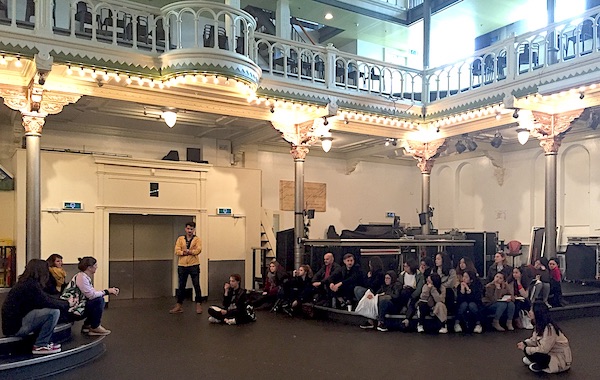
- Next to Paradiso, we find De Balie. The building used to be the District Court, which came with long ranges of prison cels to hold suspects and convicts. In the very early 1980's when we were launched a brand new Dutch 'modern music magazine' called Vinyl, we rented a handful of the very narrow cells in the then freshly evacuated building from the city of Amsterdam, as editorial offices and studio space for the designers 😎. The city council not long after agreed on a full cultural destination for the building, eventually resulting in De Balie's current function as a stage for artists, scientists and activists, often combining lecturing, debating, theatre, performance, film and visual arts.
-
De Stadsschouwburg is a fine building in neo-Renaissance style that dates back to 1894. It is the former home of the Dutch National Ballet and Opera, whose current base is the Nationale Opera & Ballet building, familiarly known as Stopera or Het Muziektheater Amsterdam, facing the Amstel river and the Waterlooplein.
The Stadsschouwburg nowadays is home to the 2018 merger between Stadsschouwburg Amsterdam and Toneelgroep Amsterdam, which as of this 2018/2019 seasons operate under the name ☆ International Theatre (ITA), a company whose chosen mission it is to become "a beacon for contemporary theatre and cater to audiences from Amsterdam and around the world, [by producing] a high-quality programme with 600 pluriform national and international theatre and dance performances every year".
We saw Oedipus, an adaptation by English writer and theatre director Robert Icke, of Sophocles' classic tragedy Oedipus Rex, played and produced by the ITA-sensemble. [[tweet]] [up] - De Melkweg is a music venue and cultural center on the Lijnbaansgracht, almost on the Leidseplein. De Melkweg programs live music, performances, theatre, debates, club nights, photography, cinema, festivals. The name ('Milky Way') is due to the fact that the building used to house a ... sugar refinery, that in the 1920s was bought by a milk company. Towards the end of the 1960s the milk company left, and in 1970 the city of Amsterdam destined the building to house a cultural (youth) center. The (hippy and pop music) spirits of those years, including —prominently— the Dutch and especially the Amsterdam authorities' highly tolerant and permissive attitude towards the use (and sell/buy for personal consumption) of (psychedelic) drugs, quickly made De Melkweg the second (next to Paradiso) most important pop and progressive rock venue in Amsterdam and the low countries, for many years attracting a great many young people from all over the world.
- De La Mar Theater, in the Marnixstraat, just next to the Leidseplein
- Theater Bellevue, also next to the Leidseplein, on the Leidsekade
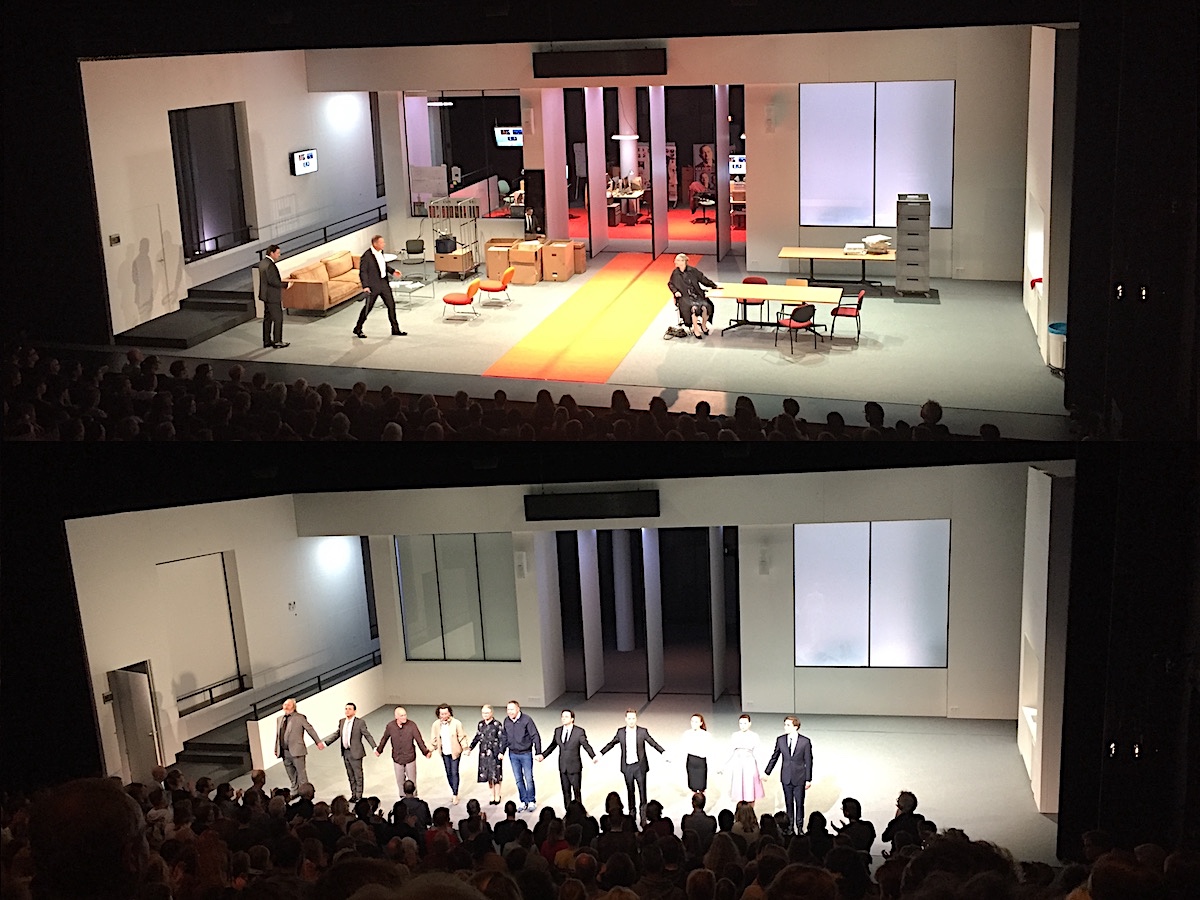
Waterlooplein area
- Dutch National Opera and Ballet [Stopera, Muziektheater]. The large 'modern' building complex that occupies the bend of the river Amstel between the Waterlooplein (Waterloo square) and the Zwanenburgwal, on a small peninsula called Vlooienburg (a piece of land reclaimed from the river in the 16th century) houses both Amsterdam's principal opera house and the city's town hall. The erection of a new Amsterdam opera house and a new town hall had been over 60 years in the making. The opera house finally opened in 1986, the new town hall two years later, in 1988. The planning and construction of the building in the middle of the largely abandoned former Jewish district, most of the original occupants of which had been deported and were killed in German concentration camps in the course of the Second World War, was highly controversial and contested by large parts of the Amsterdam population. This actually accounts for the building's colloquial name, the Stopera, an abbreviation of "Stop de Opera!" (Stop the Opera!)... The opera/town hall's construction in the 1980's met with heavy, physical, protests, in particular from the then quite powerful and influential left-wing counterculture and squatters movement, and gave rise to a series of riots, and battles on and around the Waterlooplein between police and protesters. Many Amsterdammers nowadays still refer rather pejoratively to this 'temple of high culture', e.g. calling it the Kunstgebit (meaning "Arti-ficial Teeth"). Though known by everyone as the Stopera, due to its origin, the Dutch National Opera and Ballet never uses this name in official communications.
- Koninklijk Theater Carré (Royal Theatre Carré). Facing the river Amstel, a theatre built in classicist style, and originally called Circus Carré, meant as the permanent location for a circus. Theater Carré programs a broad range of musicals, musical theatre, cabaret performances and pop concerts. Artists' protests managed to prevent the planned demolition of the building at the end of the 1960s, and in the 1970s it was bought by the city of Amsterdam. At the occasion of the theatre's centenary, Theater Carré was granted the predicate Koninklijk (Royal).
- Hermitage Amsterdam. Also facing the Amstel, a bit further along the river in the direction of the Stopera, the former Amstelhof dating back to the late 17th century, in 2009 became the location of Hermitage Amsterdam, a branch of the Russian Hermitage Museum in Saint Petersburg. Situated within the Hermitage is the Outsider Art Museum.
- Museum Het Rembrandthuis (Rembrandt House Museum). The Dutch master painter and an art-star already in his lifetime Rembrandt van Rijn was far less gifted as a manager of his financial affairs. In 1639, when he was relatively well-to-do, the painter bought a big house in the Jodenbreestraat (in Rembrandt's days the street's name was Breestraat), on the corner of the Waterlooplein. He lived and worked there for almost twenty years. However, the artist also took up the habit of borrowing heaps of money, notably from the then mayor of Amsterdam, Cornelius Jan Witsen, to buy expensive works of art, exclusive garments (not to wear, but for use in his paintings) and exotic objects. He was unable to pay back the mayor, who filed a petiton for Rembrandt's bankruptcy. In 1658 the house and the sumptuous collection of art and artefacts were sold in a public auction.
In 1907 Rembrandt's former dwellings, the condition of which had badly degraded in the 250 years since its public sale, were bought by the city of Amsterdam. The house was restored, and opened in 1911 as a museum dedicated to Rembrandt's life and art.
☆ Amsterdam Dance Event (ADE)
The Amsterdam Dance Event is an annual electronic music festival, that comes with a full program of daytime conferences, workshops, etc. It started in 1995 and current editions feature 1000 events and over 2,500 artists, with programs spanning more than five days and nights in some 200 clubs & venues. The shows attract more than 400,000 visitors from all over the world to the city, making Amsterdam into one of the busiest clubbing cities in the world. The ADE is organised by The Amsterdam Dance Event Foundation.
On Friday we visited the ADE's new office space, in the Vondelparkpaviljoen, a nice renaissance-style building built in the late 19th century. In recent decades (1972-2012) the building was home to the Filmmuseum, until it moved to its new location on the north bank of Amsterdam's waterfront, behing the Central Station. After reconstruction works, in 2014 the building became home to the media and culture lab of AVRO/TROS, one of the Dutch public broadcasting associations, and renamed VondelCS.
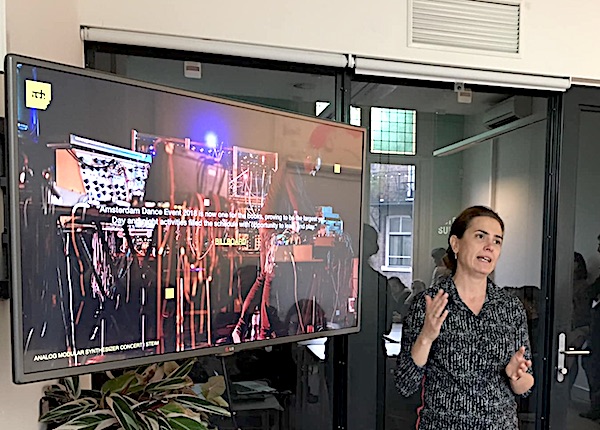
In VoncelCS we met with ADE director Mariana Sanchotene, and with VondelCS's director Marlies Buurman. [up]
☆ Gerrit Rietveld Academie
The Gerrit Rietveld Academy is a prestigious Dutch academy for fine arts and design, with a profoundly international orientation (about 60% of the student population comes from abroad, most classes are taught in English). The Rietveld, as it is generally known, is renowned for its idiosyncratic and autonomous character and (slightly subversive) view on and approach to arts, art-teaching and art-making. Since 1967 the academy can be found in the Frederik Roeskestraat in the Zuidas, a little to the south of the city centre. The main building there was designed by Dutch architect and designer Gerrit Rietveld, a leading member of the Dutch artistic movement De Stijl (also known as 'neoplasticism'), along with e.g. Theo van Doesburg and Piet Mondrian. The school got its current name in 1968 as a tribute to Rietveld, who died in 1964, some years before the building he designed was finished.
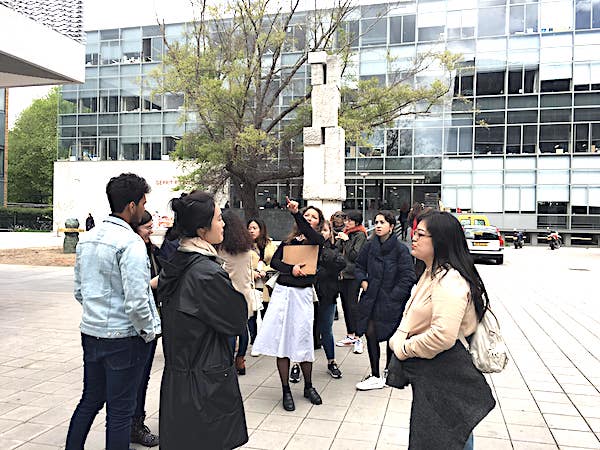
We visited the Gerrit Rietveld Academie on Friday, met artists and professors Hans Muller and Maarten de Reus, were given a short tour of the school by Gersande Schellinx and saw & discussed a selected number of students' works in progress. [[tweet]] [up]
... and also, (of) definite (of) interest...
EYE Film Institute Netherlands
The EYE filmmuseum presents and preserves a large collection of Dutch and foreign movies.
Mediamatic
Mediamatic is a centre dedicated to art and new technologies, founded in 1983 in the northern city of Groningen by Willem van Velthoven. Mediamatic moved to Amsterdam in 1986, where it has occupied a wide range of different spots and location. Currently the centre is based at the top of the Dijksgracht, to the east of the Central station. Mediamatic organises lectures, workshops and art projects within an international network that focuses on nature, biotechnology & art/science.
De Waag
De Waag operates inter-disciplinarily, where art, science, technology and society meet, intersect, sometimes clash. The association continues to be based in the very centre of the city, in a fascinating ancient weighing-house (that's the meaning of 'waag') on the Nieuwmarkt.
OCCII (Onafhankelijk Cultuur Centrum In It)
OCCII is a self-sustainable and independent venue for alternative, underground, experimental (rock and electronic) music on the Amstelveenseweg, mostly run by volunteers, in a building originally squatted in 1984 and then legalised five years later, in 1989. It is part of an autonomous cultural complex (autonomous, hence not a 'broedplaats') called De Binnenpret (that's Dutch for 'private joke'), which also includes a library, a restaurant, a theatre for kids (Kinderpret), a hackerspace (Lag), recording studio, rehearsal studio's...